|
Revolver accuracy can sometimes be a source of
constant aggravation (see Jeff's earlier writing on this
subject at Revolver Accuracy). Shooters experiment with various loads and
bullet designs trying to achieve groups that donít resemble
buckshot from a skeet gun. Some revolvers exhibit good accuracy
with little or no effort at all, while others of seemingly the
same quality will not shoot a decent group no matter the amount
of work and frustration involved. There are many variables in
getting a revolver to shoot accurately, and most gun makers do a
good job, at least on their hunting guns. With everything that
the bullet must endure before leaving the muzzle of a revolver,
it is sometimes amazing that they can place a bullet close to
the intended target. In this article, I will not attempt to
address every element of revolver accuracy, but one particular,
and crucial variable: the cylinder throats.
The cylinder throat on a revolver plays an
important part in revolver accuracy in a couple of ways. The job
of the cylinder throat is to guide the bullet from the cartridge
case into the throat of the barrel. Assuming that the barrel and
cylinder are properly aligned, the transition from cartridge
case to the rifling of the barrel should be a smooth one, with
any slight misalignment corrected by the forcing cone of the
barrel.
Problems occur that are detrimental to accuracy
when the cylinder throats are not sized properly in relation to
the groove diameter of the barrel. The cylinder throats should
be the same as, or slightly over, the groove diameter. When a
throat is too large, the bullet will be "bumped up"
upon firing to fill the throat and then squeezed back down upon
entering the bore. In my experience, this is not much of a
problem with modern guns. The opposite of this condition is when
the cylinder throats are undersized, or smaller than the groove
diameter of the barrel. In this situation, the bullet is
squeezed down upon entering the cylinder throat and then bumped
up when entering the barrel to fill the groove diameter. The
problem occurs when the bullet, which is now undersize for the
barrel, does not bump up to proper diameter. This happens with
both hard cast bullets and jacketed bullets, leaving a bullet
traveling down the bore without a good seal or proper rifling
engagement, resulting in excessive bore leading and imperfect
alignment upon leaving the muzzle, and the result at the target
is poor accuracy.
It would seem that after over 150 years of
revolver manufacture, that those involved in the process would
have settled upon a proper diameter for cylinder throats in
relation to barrel dimensions, but it just ainít so. Oddly,
the problem occurs most often with our oldest centerfire
revolver cartridge in common use; the .45 Colt. This cartridge
has been with us for almost 130 years, and still guns are being
shipped daily with undersize cylinder throats. I have also
observed this condition on new revolvers chambered for the .32
Magnum cartridge. I have several sixguns chambered for the .44
Magnum and Special, the .38 Special, and the .357 Magnum, all
with properly sized cylinder throats. I have a few older .45
Blackhawks that have perfectly sized throats. I also have some
newer .45 Rugers that have cylinder throats that are too small.
I have a pair of .45 Ruger Vaqueros that were shipped with a
proper bore diameter of .452, with cylinder throat diameters of
between .4505 to .451. I like to shoot the excellent Cast
Performance gas-checked bullets (see Jeff's article at Cast Performance)
in all of my revolvers for their
superb quality, power, and accuracy, but in these two Vaqueros
not even these fine bullets would shoot accurately.
Brownells gunsmith supply sells a tool to
correct the problem of undersize cylinder throats on .45 caliber
revolvers. The tool consists of a throat reamer that will open
the throats up to .4525, and a pilot bushing to insure proper
alignment of the reamer. They also sell a pack of five assorted
pilot bushings to allow for perfect alignment in throats of
various sizes. The only other item needed, is a T-handle to turn
the reamer, such as is used to turn a threaded tap.
For purposes of this article, I started with the
aforementioned pair of .45 Vaqueros. These two revolvers are,
except for serial number, identical. They were built about a
year apart, but dimensions in barrels and cylinders are the
same. Both guns were fired at a range of 25 yards with several
different loads, varying from light plinking loads, to heavy
hunting loads, with cast and jacketed bullets of semi-wadcutter,
roundnose, flatnose, and hollow point design. One thing that
these two revolvers shared was consistency. All loads tested
grouped between three and one-half to four inches, regardless of
bullet design or velocity. Point-of-impact varied with bullet
weight and velocity, but accuracy was very consistent. It really
sucked.
After the initial accuracy tests, the cylinders
were removed from both guns, and the throats were reamed as per
the instructions provided. The procedure is very simple, and all
work is done easily by hand. It basically involves fitting the
pilot bushing to the cylinder throat, oiling the tool, and
turning the T-handle. Both cylinders were reamed, cleaned and
back in the two Vaqueros within 35 minutes. The guns were then
again fired for accuracy using the same loads as previously
fired. The results were amazing. With plinking loads, the
accuracy was improved by about one and one-half inches at 25
yards, grouping into about two and one-half to two and
three-quarters inches.
With the heavier bullets, such as the Cast
Performance 335 grain gas check and the Hornady 300 grain JHP,
accuracy was greatly improved in both revolvers. The guns were
still very consistent, but accuracy no longer sucked. Both
revolvers now shoot into one and three-quarters inches at 25
yards, and that is with the fixed Vaquero standard sights. That
is as good as I can shoot this type of sight. These two Vaqueros
were transformed from a couple of great plinking revolvers into
a pair of accurate sixguns for hunting or serious shooting.
They are light, handy, and powerful, with the accuracy to
reach distant targets with confidence. They are now what they
should have been all along. Iím not picking on Ruger here, as
they are not alone in this problem, and are building these guns
as they think best, but in my experience, the throat diameters
need to be increased.
There are untold thousands of good .45 revolvers
that could benefit from this simple procedure, with more being
made every day. If you have a .45 Colt, .45 ACP, or .45 Auto Rim
revolver, shoot it first. If it is accurate, you are blessed. If
it is not, the problem could be undersize cylinder throats, and
Brownells has the answer. The reamer with the extra pilot
bushings costs about a hundred bucks, but will do many cylinders
and last forever if used properly. The reamer with only the .448
bushing is $65, but I highly recommend the extra bushings. You
can find Brownells on the web at: www.brownells.com
or call them at: 641-623-4000. The part number is
513-000-001 for the reamer, and 513-000-002 for the extra pilot
bushings.
Jeff Quinn
  
Ed. Note: these reamers are available for the
same price direct from the manufacturer at:
Dave Manson Precision Reamers
8200 Embury Road
Grand Blanc, MI 48439
1-810-953-0732
Boge Quinn
  
Got something to say about this article? Want to agree (or
disagree) with it? Click the following link to go to the GUNBlast Feedback Page.
|
|
Click pictures for a larger version
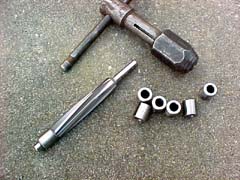
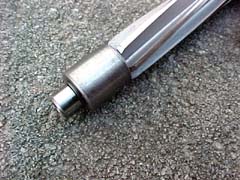

Brownells' cylinder throat reaming tool is a simple and
relatively-inexpensive way to solve a common accuracy problem
with .45 revolvers: undersize cylinder throats. As tested, the
reamer kit consists of the cutting tool and six pilot
bushings. A T-handle, commonly seen in tap sets, and oil are
the only other items needed.
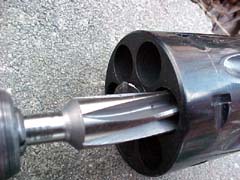
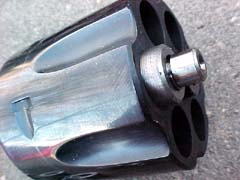

The reamer tool is easy to use, even for the
inexperienced pistolero.

Guns tested for this article were two identical Ruger
Vaquero .45s. Prior to testing of the Brownells tool, these
two sixguns exhibited great beauty, exceptional handling
qualities, and terrible accuracy.

Test loads included some of the author's favorite .45
Colt loads, including the great Cast Performance 335-grain gas
checked bullet (3rd from left). These loads have proven to be
very accurate in guns with properly-sized cylinder throats.
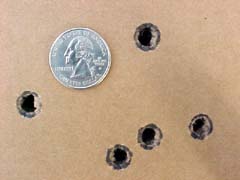
Prior to testing of the Brownells tool, "Gun
#1" (shown at left above) was slightly more accurate (or
less inaccurate) than "Gun #2". Gun #1 consistently
sprayed groups of about 3-1/2" with any
reasonably-accurate load.
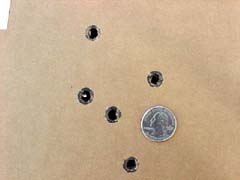
Gun #2 was also consistently inaccurate prior to testing
of the Brownells tool, producing patterns (one hesitates to
call them "groups") of about 3-3/4".

Author bench-testing the test Vaqueros. Jeff's lack of
patience with inaccurate revolvers is well-known, and led him
to test the Brownells cylinder throat reamer.
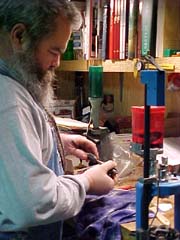
Author found the Brownells tool very easy and intuitive
to use. Both Vaqueros were completed and reassembled in less
than 35 minutes.
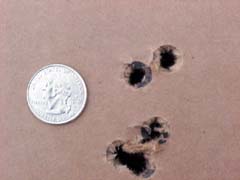

Results were amazing, with both guns now capable of
consistent accuracy of 1-3/4" at 25 yards, which is as
well as the author can shoot with the rudimentary Vaquero
sights. For less than a hundred bucks, this tool is a great
solution for a common problem with modern .45s and will last
forever given proper care. Jeff considers the Brownells
cylinder throat reaming tool a necessity for the serious .45
shooter.
|
![]()